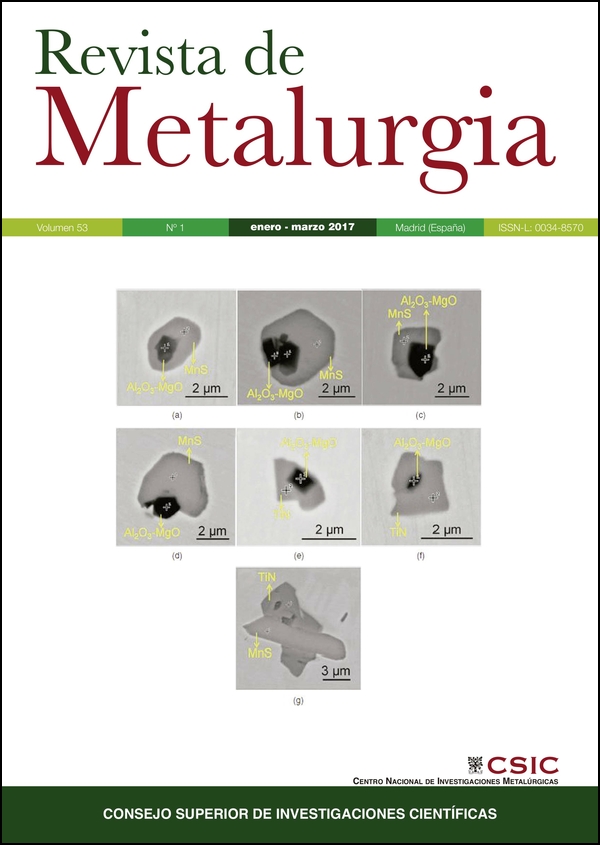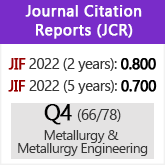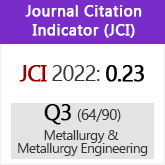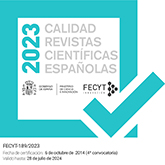Effect of tool rotational speed and penetration depth on dissimilar aluminum alloys friction stir spot welds
DOI:
https://doi.org/10.3989/revmetalm.090Keywords:
Aluminum alloys, Dissimilar welding, Friction Stir Spot Welding, Peel testAbstract
In the last years, the automotive industry is looking for the use of aluminum parts in replace of steel parts in order to reduce the vehicles weight. These parts have to be joined, for instance, by welding processes. The more common welding process in the automotive industry is the Resistance Spot Welding (RSW) technique. However, RSW of aluminum alloys has many disadvantages. Regarding this situation, a variant of the Friction Stir Welding process called Friction Stir Spot Welding (FSSW) has been developed, showing a strong impact in welding of aluminum alloys and dissimilar materials in thin sheets. Process parameters affect the characteristics of the welded joints. However, the information available on this topic is scarce, particularly for dissimilar joints and thin sheets. The aim of this work was to study the effect of the rotational speed and the tool penetration depth on the characteristics of dissimilar FSS welded joints. Defects free joints have been achieved with higher mechanical properties than the ones reported. The maximum fracture load was 5800 N. It was observed that the effective joint length of the welded spots increased with the tool penetration depth, meanwhile the fracture load increased and then decreased. Finally, welding at 1200 RPM produced welded joints with lower mechanical properties than the ones achieved at 680 and 903 RPM.
Downloads
References
ASTM E384 (2009). Standard Test Method for Microindentation Hardness of Materials, ASTM, USA.
Bozkurt, Y., Bilici, M. (2013). Application of Taguchi approach to optimize of FSSW parameters on joint properties of dissimilar AA2024-T3 and AA5754-H22 aluminum alloys. Mater. Design 51, 513–521. https://doi.org/10.1016/j.matdes.2013.04.074
Chowdhury, S., Chen, D., Bhole, S., Cao, X., Wanjara, P. (2012). Lap shear strength and fatigue life of friction stir spot welded AZ31 magnesium and 5754 aluminum alloys. Mater. Sci. Eng. A. 556, 500–509. https://doi.org/10.1016/j.msea.2012.07.019
Cox, C., Gibson, B., Strauss, A., Cook, G. (2014). Energy input during friction stir spot welding. J. Manuf. Process. 16 (4), 479–484. https://doi.org/10.1016/j.jmapro.2014.05.007
European Aluminium Association (2015). The Aluminium Automotive Manual, http://c.ymcdn.com/sites/www.aec.org/resource/resmgr/PDFs/1-Intro_2015.pdf [accessed 26. 06.15].
Ferjutz, K., Davis, J.R. (1993). Metal Handbook. Welding Brazing and Soldering. Vol. 6, ASM International, USA.
Francesco, L., Svoboda, H. (2013). Efecto de las variables de proceso de Soldadura de Punto por Fricción Agitación (FSSW) de aluminio en las propiedades mecánicas. FIUBA, Buenos Aires, Argentina.
Hirasawa, S., Badarinarayan, H., Okamoto, K., Tomimura, T., Kawanami, T. (2010). Analysis of effect of tool geometry on plastic flow during friction stir spot welding using particle method. J. Mater. Process. Technol. 210 (11), 1455–1463. https://doi.org/10.1016/j.jmatprotec.2010.04.003
Jenney, C.L., O'Brien, L. (2001). Welding Handbook. Welding Science and Technology, Vol. 1, ASM International, USA.
Jeon, C., Hong, S., Kwon, Y., Cho, H., Han, H. (2012). Material properties of friction stir spot welded joints of dissimilar aluminum alloys. Trans. Nonferrous Met. Soc. China. 22 (3), s605?s613. https://doi.org/10.1016/s1003-6326(12)61772-5
Kou, S. (2003). Welding Metallurgy. Second Edition, John Wiley & Sons, Hoboken, Canadá.
Lathabai, S., Painter, M., Cantin, G., Tyagi, V. (2006). Friction spot joining of an extruded Al–Mg–Si alloy. Scripta Mater. 55 (10), 899–902. https://doi.org/10.1016/j.scriptamat.2006.07.046
Lohwasser, D., Chen, Z. (2010). Friction Stir Welding. From basics to applications. Woodhead Publishing Limited, Oxford Cambridge. https://doi.org/10.1533/9781845697716
Mishra, R., Mahoney, M. (2007). Friction Stir Welding and Processing. ASM International, Materials Park, Ohio.
Pereira, A., Ferreira, J., Loureiro, A., Costa, J., Bártolo, P. (2010). Effect of process parameters on the strength of resistance spot welds in 6082-T6 aluminium alloy. Mater. Design 31 (5), 2454–2463. https://doi.org/10.1016/j.matdes.2009.11.052
Piccini, J., Svoboda, H. (2015a). Effect of the tool penetration depth in Friction Stir Spot Welding (FSSW) of dissimilar aluminum alloys. Proc. Mat. Sc. 8, 868–877. https://doi.org/10.1016/j.mspro.2015.04.147
Piccini, J., Svoboda, H. (2015b). Effect of pin length on Friction Stir Spot Welding (FSSW) of dissimilar Aluminum-Steel joints. Proc. Mat. Sc. 9, 504–513. https://doi.org/10.1016/j.mspro.2015.05.023
Rao, H., Yuan, W., Badarinarayan, H. (2015). Effect of process parameters on mechanical properties of friction stir spot welded magnesium to aluminum alloys. Mater. Design 66 (Part A), 235–245. https://doi.org/10.1016/j.matdes.2014.10.065
Shome, M., Tumuluru, M. (2015). Welding and Joining of Advanced High Strength Steels (AHSS). Elsevier, Cambridge, UK. https://doi.org/10.1016/b978-0-85709-436-0.00001-1
Tozaki, Y., Uematsu, Y., Tokaji, K. (2007). Effect of tool geometry on microstructure and static strength in friction stir spot welded aluminum alloys. Int. J. Mach. Tool. Manu. 47 (15), 2230–2236. https://doi.org/10.1016/j.ijmachtools.2007.07.005
Tran, V., Pan, J., Pan, T. (2009). Effects of processing time on strengths and failure modes of dissimilar spot friction welds between aluminum 5754-O and 7075-T6 sheets. J. Mater. Process. Technol. 209 (8), 3724–3739. https://doi.org/10.1016/j.jmatprotec.2008.08.028
Vander Voort, G.F. (2004). Metal Handbook. Metallography and Microstructures, Vol. 9, ASM International, USA.
Wang, D.-A., Lee, S.-C. (2007). Microstructures and failure mechanisms of frictions stir spot welds of aluminum 6061-T6 sheets. J. Mater. Process. Technol. 186 (1-3), 291–297. https://doi.org/10.1016/j.jmatprotec.2006.12.045
Yang, Q., Mironov, S., Sato, Y., Okamoto, K. (2010). Material flow during friction stir spot welding. Mat. Sci. Eng. A 527 (16-17), 4389–4398. https://doi.org/10.1016/j.msea.2010.03.082
Yuan, W., Mishra, R., Webb, S., Chen, Y., Carlson, B., Herling, D., Grant, G. (2011). Effect of tool design and process parameters on properties of Al alloy 6016 friction stir spot welds. J. Mater. Process. Technol. 211 (6), 972–977. https://doi.org/10.1016/j.jmatprotec.2010.12.014
Zhang, Z., Yang, X., Zhang, J., Zhou, G., Xu, X., Zou, B. (2011). Effect of welding parameters on microstructure and mechanical properties of friction stir spot welded 5052 aluminum alloy. Mater. Design 32, 4461–4470. https://doi.org/10.1016/j.matdes.2011.03.058
Published
How to Cite
Issue
Section
License
Copyright (c) 2017 Consejo Superior de Investigaciones Científicas (CSIC)

This work is licensed under a Creative Commons Attribution 4.0 International License.
© CSIC. Manuscripts published in both the printed and online versions of this Journal are the property of Consejo Superior de Investigaciones Científicas, and quoting this source is a requirement for any partial or full reproduction.All contents of this electronic edition, except where otherwise noted, are distributed under a “Creative Commons Attribution 4.0 International” (CC BY 4.0) License. You may read here the basic information and the legal text of the license. The indication of the CC BY 4.0 License must be expressly stated in this way when necessary.
Self-archiving in repositories, personal webpages or similar, of any version other than the published by the Editor, is not allowed.


















